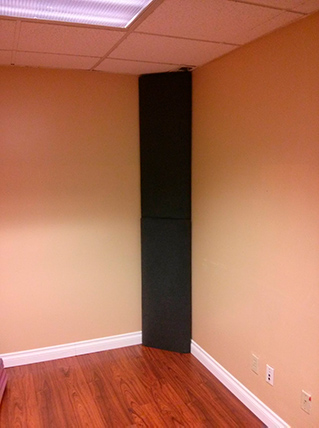Happy Winter Holidays from Acoustic Panels Art team! In this tutorial we will show you how to build bass traps for home recording studio:
Building DIY bass traps using porous absorbers easier to design and build, as well as less expensive than resonant absorbers. The porous absorbers are also more broadband and do not require tuning. In general, the thicker the absorber – the lower frequency it will absorb.
This video was a demonstration how to make bass traps functional and visually appealing. We did not really get into the specifics of designing and function of the corner bass traps. The acoustic felt panels that were used in this particular video can be found at www.AcousticPanelsArt.com.
There are two options for acoustic sound panels with image. Regular Acoustic panels for sound absorption – Acoustic Felt Panels with Custom Imprint – Acoustic Panels Art.
These panels you can see installed in the drop down ceiling looking like real clouds and working as sound clouds.
In the actual corners we used the acoustic panel with limp mass membrane – Soundproofing Acoustic Panels with Custom Imprint by Acoustic Panels Art.
Sound Absorption can be obtained by three primary mechanisms:
• porous absorption materials – sound energy absorbed by friction and converted to heat;
• panel resonators – some sort of rigid panel (sheet metal drywall, plywood, glass etc.) would resonate is response to sound waves. Any flexible panel which vibrates in response to incident sound will transmit some sound energy to the other side (and therefore decrease the reflected sound). The effect is most pronounced at low frequencies;
• volume resonators – these are Helmholtz resonators. They work well if you can include them in the original construction, but are not well suited for retrofit.:
So I will try to create a short summary of building and using a bass trap out of porous materials:
Although porous materials are more effective for absorbing high frequency sounds, the effectiveness depends on the thickness, relative to the sound wavelength.
In order to be effective (nearly anechoic) at a given frequency, the material thickness must equal to at least ¼ of a wavelength. It is difficult to obtain low frequency absorption with porous materials (they would have to be very thick).
1. Design: Bass trap consists of a thick and relatively dense sound absorbing core, some sort of framing to contain that material and an acoustically transparent fabric to keep that absorption material from going all other the place. The frame and the fabric are there to simply hold the sound absorber together in manageable form.
2. Positioning: Since porous bass trap absorbers need to be very thick to be effective at lower frequencies so they tend to be positioned as diagonal wedges in the corners Low frequency absorption of porous materials can be increased by mounting them with an airspace behind them.
Definition: Bass traps are sound energy absorbers which are designed to reduce low frequency sound energy. The purpose of that is to achieve a flatter low frequency room response by reducing low frequency sound resonances in rooms. Bass traps are commonly used in recording studios, mastering rooms, home theatres and other rooms built to provide a critical listening environment.
For more innovative products to get the best audio recording in your home recording studio, acoustic room treatment, DIY vocal booth or home soundproofing solutions go to https://www.vocalboothtogo.com/. Home of Producers Choice Acoustic Blankets, VOMO portable vocal booth, Soundproof-er Sound booths and many more acoustic treatments to optimize sound absorption and increase noise reduction. Recording Studios, Vocal professionals, Voiceover artists, Audio Engineers, and Home studios use our products every day to control their sound environment and record beautiful audio!
